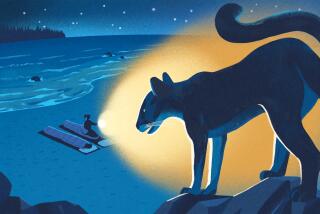Urbanization and Hunting Moratorium Put More Mountain Lions Into a Smaller Area
The last of the true mountain lion hunters in Orange County was the late Leo F. Douglass, a leathery, tobacco-chewing, squinty-eyed man who bagged his first lion in 1928.
In 1970, at the age of 77, he made his final kill--before a moratorium was declared on hunting the big cats whose numbers were feared to be dwindling.
Douglass’ tracking and shooting of the animal was not done strictly for sport.
“This friend of mine, Ermine Smith, put 12 Shetland ponies in a corral up near the head of Fremont Canyon and went off on vacation,” Douglass said in a 1973 interview. “I told him, Ermine, as sure as you’re born, a mountain lion’s gonna get ‘em.”
Douglass was right.
When Smith got back from his vacation, only seven ponies were alive. All that was left of the others were some hair and bones. Douglass and his hounds tracked and treed a 110-pound female, and he shot her with his pistol.
As development and urbanization move farther into the Orange County backcountry, mountain lions and other wildlife are “getting squeezed,” said Jeffrey B. Froke, western area manager for the National Audubon Society’s Starr Ranch Sanctuary.
Indeed, a 5-year-old girl, Laura Michele Small, was mauled on March 23 on the northern border of Ronald W. Caspers Wilderness Park near San Juan Capistrano. Froke said the concentration of animals “is increasing to the point where the habitat won’t support them.”
This does not necessarily mean that mountain lions will be showing up in everybody’s backyard seeking food and water, experts say. But it’s more likely that the creatures will retreat farther into the hills. Since each individual cat’s territory will be reduced, they may eventually roam out of the Orange County area.
After the hunting moratorium went into effect, Douglass, who had been a state bounty hunter in earlier years, worked with the state Department of Fish and Game to survey the mountain lion population in the Santa Ana Mountains bordering Orange County on the east.
By 1975, Douglass and Fish and Game biologists estimated that there were about 25 of the animals in the county’s backcountry, moving with fluid grace into the open glades where deer graze, but also using their amazing stealth to avoid being seen by human beings.
‘All Around the Place’
Froke, who has been studying the cats for seven years, said: “They are all around the place up here.” He said he has actually seen only one or two of the animals but, based on tracks and other signs, Froke believes that there are probably 20 to 35--”more likely 20”--mountain lions in the vicinity of the sanctuary, Caspers Park and nearby mountains.
The lions are known to cover great distances. In some parts of the country, a single cat can have a “personal” territory of more than 200 square miles. Understanding those ranging grounds is considered important, since it could indicate where an expanding mountain lion population could be expected to roam as it is pressured by human activity.
The Audubon Society and other agencies, such as Fish and Game, believe that more information is needed about the lions, Froke said, and as a result a three-year, $140,000 study, funded by the federal government and a number of corporations, is planned to start about July 1.
“We’ll experiment with camouflaged towers and blinds to observe the cats, and we’ll attempt to tranquilize as many as possible so that we can attach radio transmitters to them,” he said.
Attack Not Explained
In this way, investigators will be able to get a more accurate head count, track the cats’ movements and determine the extent of their ranges.
As for the attack on little Laura Michele Small, Froke said he had “no answer, no strong hunch” to explain the incident.
“As far as I know, there has been no well-documented attack in California until last Sunday,” he said. “I don’t think it was typical for a normal lion to get into that kind of trouble. There had to be some kind of abnormality.
“It’s almost impossible for someone who really wants to see a mountain lion to go out and see one. They’re too secretive. For one to show up like that, it’s hard to understand.”
For anyone who might find themselves face to face with a mountain lion, Froke offered the following advice:
“Hold still, facing the lion, and try to make a lot of noise, yelling,” he said.
“Watch for his body movements, which are much like a house cat’s when it crouches and lashes its tail, and if it really threatens you, try to throw something at it--a rock or a stick.”
More to Read
Sign up for Essential California
The most important California stories and recommendations in your inbox every morning.
You may occasionally receive promotional content from the Los Angeles Times.










